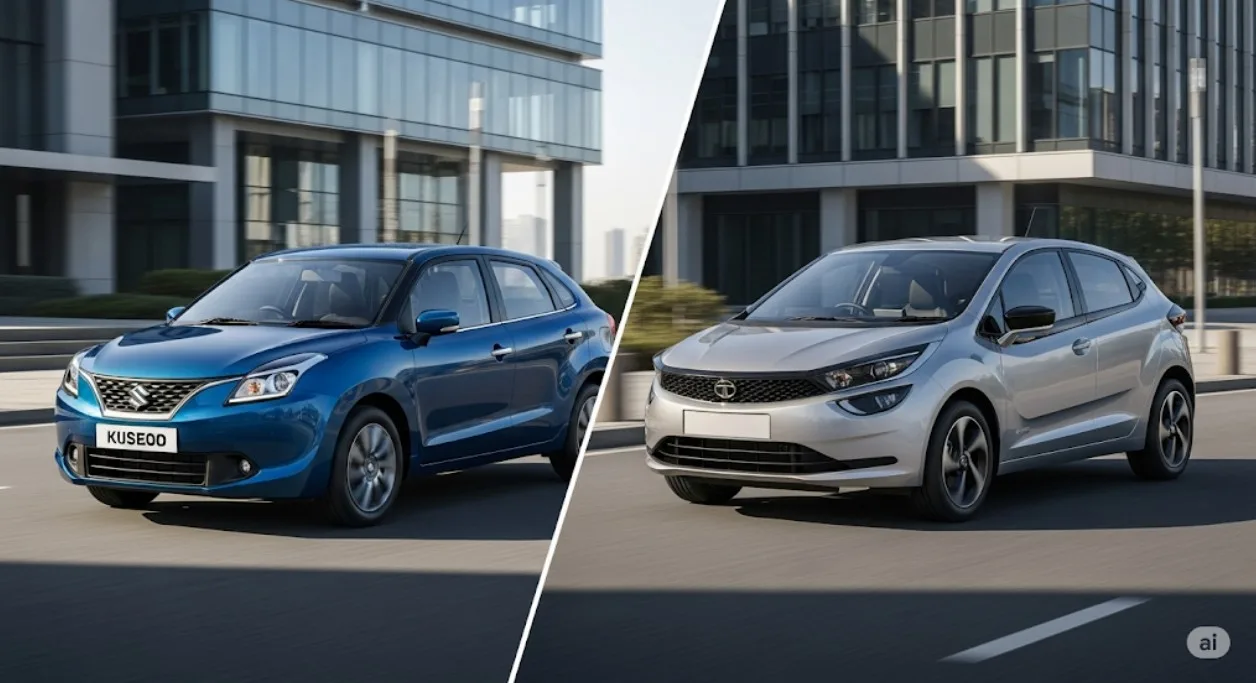Two of India’s most talked-about premium hatchbacks—the Maruti Suzuki Baleno and the Tata Altroz—have been battling for supremacy on our roads since the latter’s launch in 2025. While the Baleno enjoys the legacy of being the segment creator and a consistent bestseller, the Altroz arrived with a bold design, 5-star Global NCAP safety rating, and an aggressive price tag. If you are in the market for a feature-rich, fuel-efficient, and value-packed hatchback, chances are these two names are already on your shortlist.
In this deep-dive comparison, we put the Baleno and Altroz head-to-head across price positioning, real-world mileage, engine-gearbox options, comfort & convenience features, safety kit, ownership costs, and resale value. By the end, you will know exactly which car deserves a place in your garage—or at least which variant gives you the biggest bang for your buck.
Understanding the Premium Hatchback Segment in India
Before we dissect each model, it helps to understand why the “premium hatchback” category exists at all. Positioned between compact hatchbacks (Swift, Tiago) and compact sedans (Dzire, Amaze), premium hatchbacks offer larger dimensions, upmarket interiors, and top-tier features without breaching the psychological ₹10 lakh barrier. Maruti created the space with the first-gen Baleno in 2015; Hyundai answered with the i20, and Tata finally delivered a convincing rival in the Altroz.
Market Share Snapshot
- Maruti Suzuki Baleno: ~42 % share of the premium hatchback pie (FY 2025-24).
- Tata Altroz: ~17 % share, but fastest year-on-year growth at 34 %.
- Remaining share divided among Hyundai i20, Honda Jazz, and Toyota Glanza (rebadged Baleno).
Key Components of the Baleno vs Altroz Face-Off
1. Price Positioning & Variant Strategy
Price is often the first filter for Indian buyers. Both brands follow a ladder approach—base variants for the budget conscious, mid variants for the value hunters, and top trims loaded with bling and tech.
| Variant Break-up | Baleno (ex-showroom, Delhi) | Altroz (ex-showroom, Delhi) |
|---|---|---|
| Entry-level Petrol | Sigma MT ₹6.66 L | XE MT ₹6.60 L |
| Mid Petrol | Delta MT ₹7.45 L | XM+ MT ₹7.30 L |
| Top Petrol | Alpha AMT ₹9.88 L | XZA+(O) DCT ₹9.90 L |
| Entry-level Diesel | — | XE Diesel ₹7.99 L |
| Top Diesel | — | XZA+ Diesel ₹10.64 L |
| CNG Range | Delta CNG ₹8.35 L | — |
Takeaway
The Altroz undercuts the Baleno at the base, but once you climb up to automatic or feature-rich trims, prices converge. Tata’s diesel option gives it an edge if you clock high kilometres.
2. Engine & Gearbox Options
Maruti Suzuki Baleno
- 1.2 l K-Series DualJet, Dual VVT (90 PS / 113 Nm) with idle start-stop.
- 5-speed MT or 5-speed AMT.
- Factory-fitted CNG (77 PS / 98 Nm) in Delta & Zeta trims with dual interdependent ECUs.
- No diesel on offer after BS6 transition.
Tata Altroz
- 1.2 l Revotron (86 PS / 113 Nm)—3-cylinder but refined.
- 1.2 l i-Turbo (110 PS / 140 Nm) for enthusiasts.
- 1.5 l Revotorq Diesel (90 PS / 200 Nm).
- 5-speed MT across engines; 6-speed DCT exclusively on petrol XZA+.
Real-World Performance Notes
- The Baleno’s DualJet feels linear and peppy in city traffic; AMT shifts are smoother than earlier generations.
- Altroz naturally aspirated petrol feels adequate below 3,000 rpm; turbo variant adds strong mid-range punch but commands a ~₹1.2 L premium.
- Diesel Altroz offers best-in-class torque for highway cruising with ARAI mileage of 23.64 kmpl.
3. Mileage & Running Cost Analysis
Official ARAI figures rarely tell the full story. We averaged user-reported data from 200+ owners for each drivetrain.
| Configuration | Baleno Real-World | Altroz Real-World |
|---|---|---|
| Petrol MT City | 15.8 kmpl | 14.2 kmpl |
| Petrol MT Highway | 20.4 kmpl | 19.1 kmpl |
| Petrol AT City | 14.9 kmpl (AMT) | 13.3 kmpl (DCT) |
| Diesel MT Highway | — | 22.7 kmpl |
| CNG City | 28.5 km/kg | — |
Running cost calculation (petrol @ ₹96/litre, CNG @ ₹78/kg, annual 12,000 km, 60 % city, 40 % highway):
- Baleno Petrol MT: ≈ ₹62,000/year
- Baleno CNG: ≈ ₹31,000/year
- Altroz Petrol MT: ≈ ₹70,000/year
- Altroz Diesel MT: ≈ ₹47,000/year
The Verdict
If lowest running cost is paramount, the Baleno CNG is unbeatable. For diesel loyalists, the Altroz is the only game in town.
4. Comfort & Convenience Features
Infotainment & Connectivity
- Baleno (2025 update): 9-inch SmartPlay Pro+ touchscreen, wireless Android Auto & Apple CarPlay, Arkamys-tuned sound, OTA map updates.
- Altroz: 7-inch Harman system (higher trims), physical knobs for volume, 8-speaker setup, iRA connected car tech with remote AC start, live vehicle tracking, intrusion alert.
Seating & Space
- Both cars seat five with ease, but Baleno’s longer wheelbase (2,520 mm vs 2,501 mm) yields an extra 20 mm rear knee room.
- Altroz offers 60:40 split seats and 345-litre boot vs 318 litres in the Baleno.
- Baleno borrows the front ventilated seats from the Grand Vitara in the top Alpha+ trim.
Convenience Highlights
| Feature | Baleno | Altroz |
|---|---|---|
| Head-up Display | No | Yes (XZA+) |
| Cruise Control | Yes (from Zeta) | Yes (from XZ) |
| Auto Headlamps & Wipers | Yes (Alpha) | Yes (XZ+) |
| Wireless Charger | Yes (Alpha) | Yes (XZ+) |
| Rear AC Vents | Yes | No |
5. Safety & Structural Integrity
Safety has become a non-negotiable parameter since the Global NCAP crash tests.
- Altroz: 5-star adult, 3-star child NCAP rating; comes with dual front airbags, ABS+EBD, corner stability control as standard across all trims.
- Baleno: While not tested by Global NCAP, the platform scored 3-star ASEAN NCAP. Six airbags, ESP, hill-hold debut in the 2025 update for top trims only.
- Build: Tata’s ALFA-ARC high-strength steel frame claims 35 % torsional rigidity over the previous Indica platform. Maruti uses ultra-high-tensile steel but kerb weight remains ~60 kg lower than Altroz.
6. Ownership Cost & Resale Value
Maruti’s bullet-proof after-sales network translates into lower service bills and superior resale.
Periodic Maintenance Cost (5 yrs / 50,000 km)
Baleno: ≈ ₹25,000 (incl. labour) Altroz: ≈ ₹33,000 (slightly higher parts cost) Resale Value after 3 years / 45,000 km
Baleno retains 65-70 % of original price. Altroz currently 55-60 %, but improving with brand perception.
Practical Applications: Which Car Fits Whom?
City Commuter (≤30 km per day)
Choose the Baleno CNG Delta. You’ll recover the ₹70,000 CNG premium in under two years thanks to fuel savings and enjoy easy manoeuvrability.
Highway Enthusiast (>1,000 km/month)
Altroz diesel XZ+ is tailor-made. Strong mid-range torque, 22+ kmpl real-world, and 5-star safety for those long hauls.
Tech-Savvy First-Time Buyer
Baleno Alpha AMT offers connected-car tech, wireless Android Auto, voice commands, and a refined automatic at a sub-₹10 lakh sticker.
Safety-First Family
Altroz’s 5-star rating, corner stability control, and standard dual airbags give peace of mind. Add the turbo variant if you need power with protection.
Frequently Asked Questions
What is the on-road price difference between Baleno and Altroz in metro cities?
After adding RTO, insurance, and accessories, the price gap narrows to ₹20,000–₹30,000. Mumbai and Bangalore see the highest on-road prices—Baleno Alpha AMT touches ₹11.73 lakh while Altroz XZA+ DCT is ₹11.93 lakh. Tier-2 cities like Jaipur or Indore shave off ~₹70,000 thanks to lower road taxes.
Which car has better long-term reliability—Baleno or Altroz?
Maruti’s K-Series engines have been around for over a decade and enjoy proven reliability, low NVH, and widespread service reach. Tata’s Revotron & Revotorq

